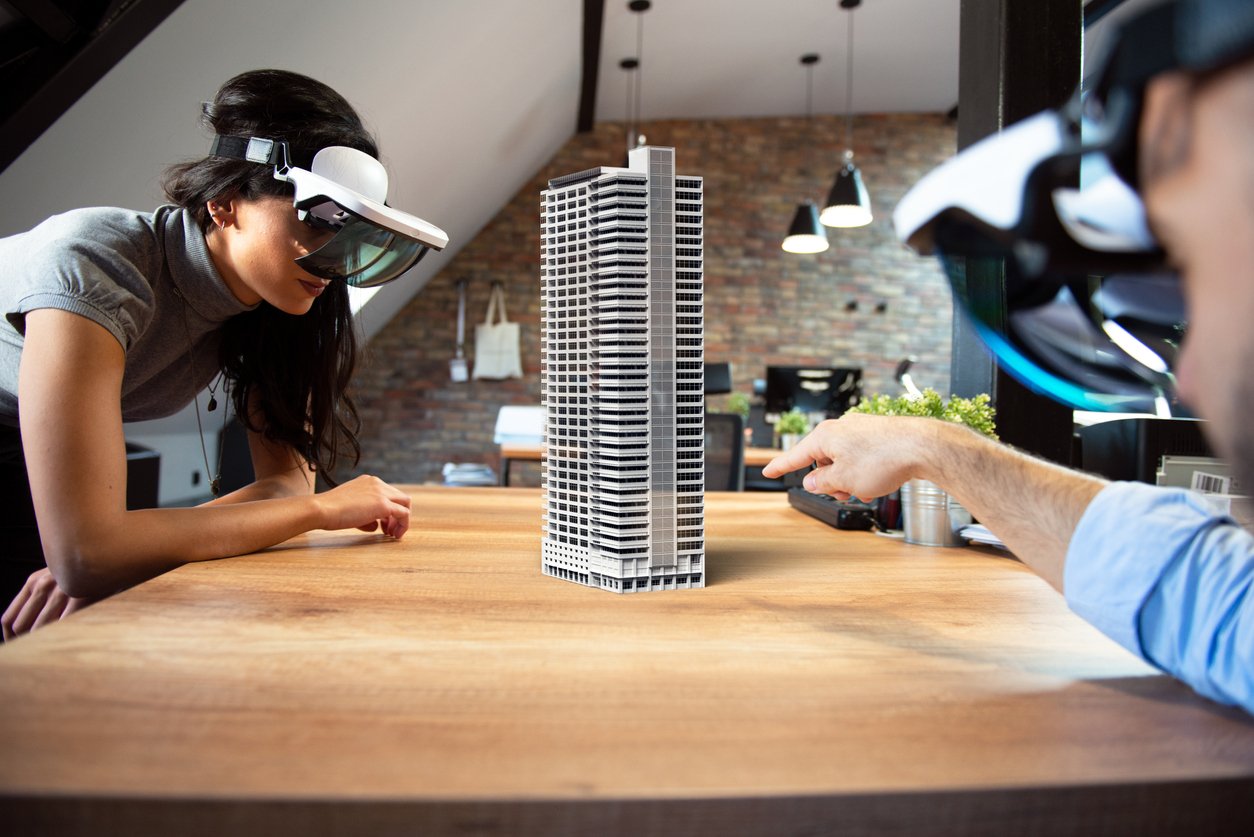Today’s business owner needs their workspace to be on the cusp of innovation. Why? Because embracing innovation in the office and building an effective tech strategy will often translate into increased productivity, improved communication with staff and clients, and enhanced employee satisfaction.
With that in mind, here are 5 of the trends we think will achieve prominence in the office space in 2020.
1. Cyber-security will be priority #1 for most businesses
As technology and AI make significant breakthroughs, so do the cybercriminals. Keeping a company secure from cyber-attacks is a gargantuan task, with enterprises often dedicating large teams to defending their data and privacy. It’s been reported that corporate security breaches have increased by 67% since 2014 (Source), and according to the American Identity Theft Resource Center, nearly 31 million records were exposed in the 13 most significant breaches in the first half of 2019. As we head into 2020, cybercriminals will be employing increasingly more sophisticated ways to attack companies in the pursuit of money and power. Using methods anywhere from ransomware to phishing scams and SMS texting attacks to social media attacks.
Cyber-security will be firmly at the top of priority lists going into 2020, and companies are taking it seriously. In fact, the International Data Corporation reports global spending on cyber-security solutions to top $103 billion in 2020, increasing to $133.7 billion in 2022.
We discuss cyber-security trends in more detail in this blog: Top 4 Cybersecurity Trends in 2019 & What to Watch for in 2020
2. Artificial Intelligence (AI) will play a role in offices of all sizes and industries

Alexa anyone? No surprise here, but AI has been touted as a “trend to watch for” for many many years, and that’s not going to change any time soon. Advancements in AI technology are constant—and fast—so every year there is something new to watch for, and 2020 will be no different.
While AI is often associated with enterprises, it is also going to be a trend that small businesses will embrace in 2020, mostly thanks to its increased affordability, and the productivity enhancements and savings it can bring with it. AI could be the missing piece in the puzzle for a small business to win customers and grow, providing new opportunities for success, leaving humans to focus on the more demanding creative work tasks.
AI is already in use in many business settings, with HR providing a prime example. AI can be used to fulfil every stage of the hiring process—from deciding which jobs need filling, writing job descriptions, vetting resumes, scheduling interviews, interviewing candidates and even onboarding new employees. AI can do all of these things faster and at a lower cost than humans could ever achieve.
In the legal sector, as another example, some programs analyze and review contracts and suggest edits based on the company’s pre-defined legal policies. This use of technology reduces the likelihood of errors and accelerates workloads and processes.
3. The customer experience will become a brand differentiator
Customer expectations are at an all-time high when it comes to communication and engagement. As consumers, we want relevant and contextual communication, where and when we need it. Preferably with a human. AI will play a significant role this year for brands looking to improve on the customer experience and their engagement. Even smaller uses of AI and algorithms can improve the user experience in nearly all industries. Chatbots, for example, will be able to understand the context of a customer enquiry better, understand what the customer is asking, as well as display emotions such as empathy. The idea is that eventually, the customer will not be able to tell the difference between a chatbot and a real human. And of course, integrating AI into the customer experience and putting it at the heart of their strategy will free up human personnel for other tasks within the business.
In 2020 we will also see increased adoption of AI in call centres in areas such as dynamic interactive voice response (IVR) systems, which can link to information about customer behaviour on other channels in previous interactions, or from your CRM, for example. Advanced IVR systems allow callers to resolve straightforward customer service interactions by themselves, over the phone, without ever having to speak to a live agent. This new technology will place modern IVRs firmly as a powerful tool for customer engagement.
If chatbots and interactive voice response systems are not part of your 2020 plan, have no fear! AI will not be replacing human interaction in its entirety any time soon, especially when it comes to high-stress scenarios when nothing can beat human-to-human conversation. However, AI can help real-life customer support agents deliver amazing experiences to customers, making them more efficient, and in turn helping them serve customers better.
4. The workspace will be defined by new ways of working

Bring your own device and technology to work
Most offices provide all the equipment an employee needs to conduct their day-to-day tasks. However, in today's fast-paced environment, it can be hard for businesses to keep up with the change in tools and apps that are available to make the working day more streamlined and efficient. Therefore we are going to see a move towards employees working on their own devices, using their preferred technology and collaboration methods, rather than what is dictated by the business. Millennials are shaping today’s workplace, and a company that embraces their influence and recognizes that Millennials’ working styles are all individual and customized will see enhanced productivity and collaboration.
Remote working and coworking could become the new normal in 2020
Research shows that independent or freelance professionals make up 33% of today’s workforce, and by 2020 that number is expected to rise to 40%. Coworking spaces will become the new normal in many industries due partly to this rise in freelancers, and partly because of work style innovation and modern technology has helped foster a workforce that can be just as productive outside of the office as in it. Coworking spaces offer employees an alternative to commuting to a corporate office or may be a more convenient option for remote workers who do not have a suitable home office.
Coworking spaces are usually well-designed with modern interiors that will attract the younger workforce—open-concept workspaces alongside private offices, entertainment areas, shared kitchens etc. For the freelance professional or remote worker, the advantages of coworking spaces, aside from the obvious interaction with other professionals, include cost savings, access to better facilities, scalability, and higher workplace satisfaction, to name a few. Most coworking spaces are quite flexible and come with different monthly rental plans that can include a set number of hours of boardroom or private meeting room time.
Coworking is going to increase in the coming year, and not just for independent contractors. Small businesses are moving into coworking spaces to take advantage of the cost savings and flexibility. CoworkingResources.org estimates the number of coworking spaces worldwide to grow to almost 26,000 by 2022, many of which are predicted to open in cities with budding start-up cultures.
5. Augmented reality might make an appearance in your office

As Augmented Reality technology becomes more easily accessible and affordable, it might become more commonplace within a business environment. Whereas virtual reality (VR) is already widely used in organizations for on-the-job training and education, augmented reality (AR) is not.
Unlike VR, which uses realistic images, sounds and other sensations to simulate a user's physical presence in a virtual environment, augmented reality overlays digital information onto what you see in the actual world around you. A furniture company, for example, can use AR to allow a client to see how a custom furniture design would look in their own home before it’s even been built. It provides a more immersive experience when walking around their house and evaluating their vision as opposed to a simulated version of their home.
Conclusion
Office spaces are changing thanks to new technologies and innovations that are being researched and released at break-neck speed. These new technologies promise to change the way we do business, altering the tasks humans will complete and how work gets done. The trending technologies of 2020 will impact everything from employee working styles to customer engagement. While small to mid-sized businesses may struggle to see the need to invest in and adopt all the new and innovative solutions, they cannot risk being left in the dark ages. Competitors who are willing to take a risk and push their company into the future will likely overtake those less resistant to change and progression.
Your customers will expect you to keep up with the latest technological advancements, and being the fickle humans that we are, will not hesitate to switch to a more modern company that is changing with the times. Company leaders must take stock of their current situation, and decide what combination of the trends will drive the most innovation and strategy. Otherwise, they will find themselves a decade in the past.
Want to bring your office into the future? Reach out to us for a free office assessment today and learn about your unique options that may save you time and money.


